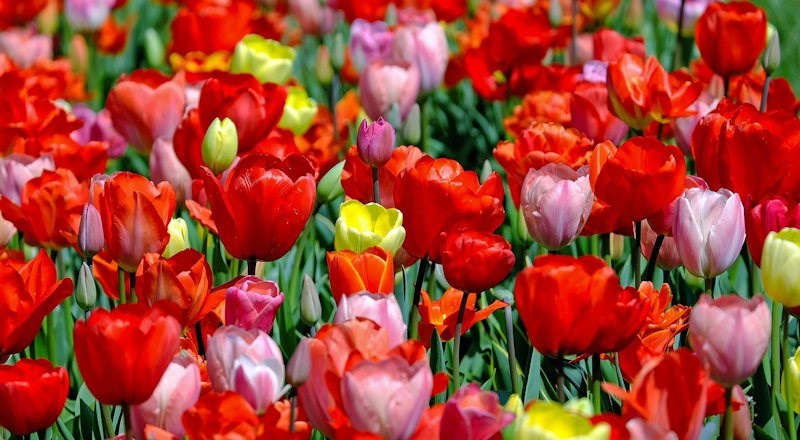How to plant spring flowering bulbs
Planting bulbs in preparation for spring is a fantastic way to ensure bright colours all season. There are always jobs needing to be done in the garden, so any chance to get ahead can give you more time. Spring bulbs are great for planting in beds, borders and potted containers, and will continue to flower year after year!

The best spring bulbs to plant
There are a wide range of bulb varieties to choose from when it comes to picking your spring plants. One thing to factor when picking what bulbs to plant is the time of year they flower. Spring bulbs have a varied flowering period from February to May. Here are the most popular options, each with their own unique flowering time:
- Allium (May flowering)
- Anemone (February – March flowering)
- Crocus (February flowering)
- Daffodil (February – April flowering)
- Snowdrop (February – March flowering)
- Hyacinth (March – April flowering)
- Iris (May flowering)
- Muscari (April – May flowering)
- Narcissi (February – May flowering)
- Tulip (April – May flowering)

When to plant spring bulbs
The optimum time to plant spring flowering bulbs is during autumn to winter, before the frost sets in and ground becomes too hard (October through to mid-December is ideal).
Bulbs planted during this period will remain dormant over winter, storing energy in preparation for the warmer temperatures of spring. A general rule of thumb is that the later the bulb is planted, the later it will flower during the season.
It is best to plant bulbs when the ground is still loose and well-watered, however you will want to avoid planting after heavy rain since this could cause bulb rot.
If the ground appears too dry, water thoroughly, and give it time to drain before planting any bulbs. It may seem like a balancing act when trying to find the best time for planting, but this can ensure the best flowering season come spring.

How to plant spring bulbs
Spring bulbs are highly versatile when it comes to being planted, but some may have more specific requirements than others. Plants such as daffodils, crocuses and tulips thrive in free draining soil and plenty of light, however snowdrops and bluebells like to be in a shadier location.
Planting in beds and borders
Garden flower beds and borders are a great place to plant spring flowering bulbs, as they provide a large area for flowers and foliage. When getting ready for planting your bulbs, you will want to follow our 6 simple steps.
1. Use a hoe to break up the soil until it is even and loose.
2. Take a bulb planter or trowel to dig a hole approximately 3 times the bulb depth.
3. Carefully place the bulb into the hole, making sure the tip (pointy top end) is facing upwards. Don’t worry if you can’t figure it out, bulbs will still grow when planted upside-down!
4. Take the trowel and carefully backfill the hole with soil. Try not to press down too firm when doing this.
5. Repeat steps 2-4 over the area you wish to fill with bulbs.
6. Once all the bulbs are planted, water the ground well to help them settle.
An alternate option when planting bulbs in beds and borders, is taking a more ‘natural’ approach. Start by breaking up the soil using a hoe and watering the ground well. Then simply scatter the bulbs randomly over the ground, followed with an even layer of compost to keep them warm. This technique will give a more rustic appearance compared to other methods.
Planting in pots and containers
A great way to spruce up your garden is by planting your spring flowering bulbs in pots and containers. Using planters, as opposed to planting into the ground, gives you flexibility to move them around to find the best spot in the garden. To ensure bright bulbs during spring, follow our recommendations for planting them.
1. Fill your chosen pot or container ¾ full with a mix of peat-free compost and grit in a 3:1 ratio.
2. Place your bulbs pointy end up, evenly over the soil with a 3-inch space between each one.
3. Cover loosely with soil until fully covered and water well.
For a show stopping spring display, try mixing up the types of bulbs you plant in each container for a variety of colour and style!
Shop planting tools at Longacres here.

Looking after planted spring bulbs before flowering
Once you have finished planting all your spring bulbs, there is little to do until they begin to flower. You mainly want to keep any eye on water levels. Rain is almost certain during autumn and winter months, but make sure the ground housing bulbs is watered well during periods of light or no rain. Should there be extremely low temperatures or snow forecast, give your bulbs an extra layer of protection using mulch or a fleece frost guard.
Shop frost guards and fleeces at Longacres here.
Shop mulches at Longacres here.







